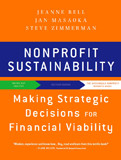
Nonprofit Sustainability: Making Strategic Decisions for Financial Viability
Jeanne Bell, Jan Masaoka & Steve Zimmerman
208 pages, Jossey-Bass, 2010
The notion of financial sustainability is something of a holy grail in the nonprofit sector these days. Virtually all nonprofit board members and executives today face financial situations that at best constrain their ability to grow or at worst threaten their very survival. On each of the six nonprofit boards on which I’ve served in recent y ears, the topic of financial sustainability has been an ongoing discussion, albeit one that too often finds itself on the back burner. The absence of strategic frameworks to help structure nonprofit leaders’ thinking and planning for sustainability certainly hasn’t helped.
Given this context, the timing seems especially ripe for Nonprofit Sustainability from co-authors Jeanne Bell, Jan Masaoka,and Steve Zimmerman. The authors, all respected nonprofit executives and consultants, have developed a framework that will help nonprofit executives take an approach that integrates financial performance and social impact considerations in strategic decision making. The book’s premise is that “financial and impact information can and must be brought together in an integrated, fused discussion of strategy,” which is true and increasingly important. Much as 21st-century corporations are integrating social responsibility and sustainability practices in their business models, 21st-century nonprofits must integrate financial considerations with their social impact priorities as well. It’s all reflective of the movement toward a broader perspective of organizational performance and the idea of “blended value” that Jed Emerson gave us many years ago.
Beyond this important premise, Nonprofit Sustainability’s primary contribution is a framework for operationalizing the integration of financial and social impact. The “Matrix Map,” a standard 2 x 2 matrix that is the trusted friend of every good consultant, is a simple but powerful model for assessing the impact and profitability of a nonprofit’s programs. In this model, programs are reclassified as “business lines” and include fundraising efforts as well. Each business line is assessed on its impact and profitability and then plotted at the appropriate point and scale on the matrix. Through this process, nonprofit executives get a clear picture of both the absolute and relative performance of each important program and fundraising effort. No doubt the picture this exercise reveals will be enlightening for many nonprofit leaders and put them in a better position to make smart resource allocation decisions. A simple, easy-to-use framework that gives nonprofit leaders sharpened strategic clarity about the value of programs and initiatives? For that alone, we should all hail the arrival of the Matrix Map.
It should be noted, and more overtly than it is in the book, that the Matrix Map is a direct descendant of Boston Consulting Group’s Growth-Share Matrix, which dates to 1968 and is familiar to everyone who has since pursued an MBA. The BCG Matrix famously gave us “Stars,” “Cash Cows,” “Question Marks,” and “Dogs,” and suggested that companies should classify and manage their product portfolios accordingly. Nonprofit Sustainability’s Matrix Map gives us “Stars,” “Money Trees,” “Hearts,” and “Stop Signs,” and suggests that nonprofits classify and manage their program portfolios accordingly. If it sounds like the Matrix Map is essentially the BCG Matrix applied to nonprofits, it’s because that’s exactly what it is. Even so, the Matrix Map’s lineage doesn’t change the fact that its application to nonprofits is at least somewhat novel, and it does create a potentially important new tool for nonprofit boards and executives.
The first half of Nonprofit Sustainability develops the Matrix Map as a model and helpfully illustrates its use and applicability through a variety of examples and situations. The second half is largely filler, seemingly purposed around the need to reach a certain page count to achieve book status. Part Four in particular, a 32-page laundry list of every imaginable fundraising and earned income vehicle, bears little relevance to the Matrix Map or its application. Rather than an encyclopedic list and description of earned income types, a chapter on how social enterprise models could be evaluated using the Matrix Map model would have been far more valuable. Similarly, although the book does devote a few pages to the Matrix Map’s usefulness in potential merger evaluations, surely there is more to say about how this tool can help facilitate nonprofit merger and joint venture activity, which has to be one of the biggest untapped opportunities in the sector.
Nonprofit Sustainability is a book that would’ve been, and probably should’ve been, a great article in the Stanford Social Innovation Review, where the core idea and useful Matrix Map could have found a larger audience. Nonetheless, I fully intended to order copies for the executive directors and board chairs I work with, until I found it priced at a whopping $35 for a paperback edition. Although Nonprofit Sustainability and its Matrix Map deliver an important idea for nonprofits, it’s an idea that should have been delivered more accessibly and affordably. Something isn’t right about a business model that takes a good (but hardly proprietary) idea for nonprofits and turns it into a high margin, low volume product. Perhaps that’s a critique of book publishers more than the authors, but Nonprofit Sustainability is ultimately a product of both.
Jim Schorr is a professor at Vanderbilt University’s Owen School of Management, where he teaches coursework on social enterprise and CSR. Previously, he was executive director of Juma Ventures and a co-founder of Net Impact. He currently serves as a trustee of the Nature Conservancy of Tennessee and as board president of Oasis Center, Nashville’s leading nonprofit organization for disadvantaged youth.

